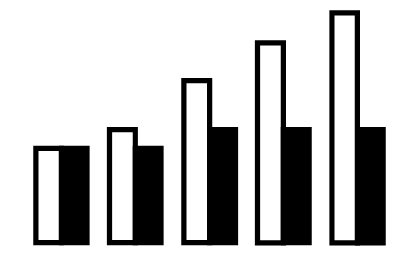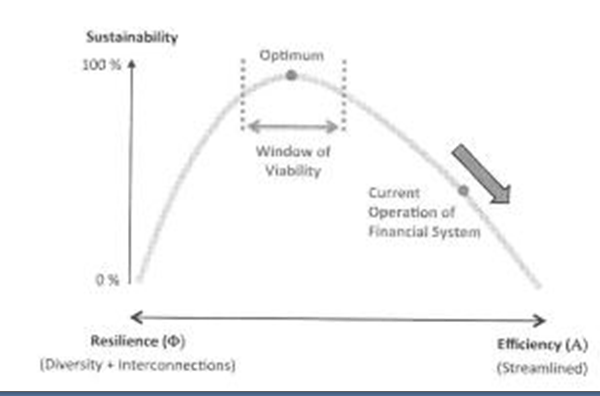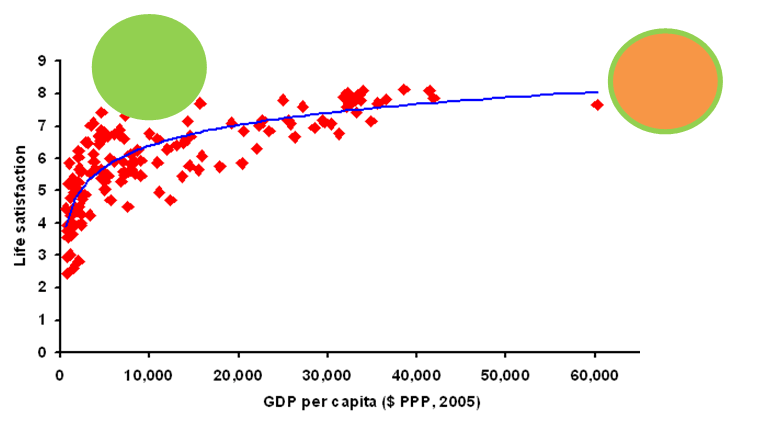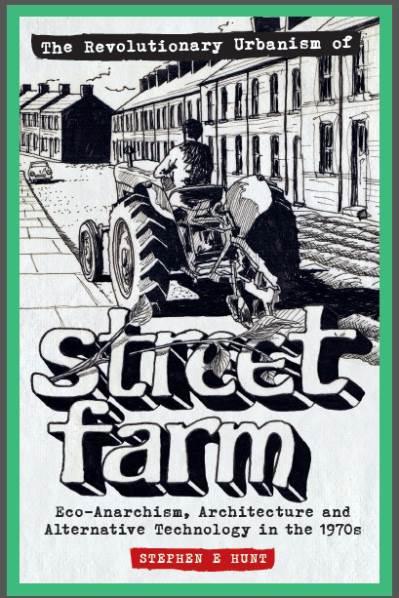DEFINING RT 2.0
The original Radical Technology (RT 1.0) defined itself elliptically, using many examples. Can RT 2.0 be more objectively characterised? Here are some attempts.
The original Radical Technology (RT 1.0) defined itself elliptically, using many examples. Can RT 2.0 be more objectively characterised? Here are some attempts.

On the whole, developments in technology have delivered increases in productivity, that is, greater functionality per unit of input, while keeping ‘externalities’ of various kinds (such as environmental impacts) at a ‘tolerable’ level. This can be symbolised by the diagram here, where open bars represent, say GDP or ‘functionality’; black bars represent externalities, i.e. diffuse costs, risks and burdens borne by all, and by the natural environment. Note that this is a best-case: many would argue that, taken broadly, the black bars are growing too.
Logically, technical development could have generated lower impacts with maintained (and qualitatively improving) functionality, symbolised by the second, lower diagram. In essence this is the default RT programme. It is undeniable that on the whole it is the first of these two cases that has emerged (so far anyway). Is it worth (perhaps) re-running the video in a counterfactual mode in which we made the opposite choices? What would the world now look like? This could be a working definition of RT, or its close synonym, AT (Alternative Technology), but what would you need to do to achieve it?


Here is another approach to objectively characterising RT. We are looking for ‘elbows’ – rational optima that are obscured or overridden by powerful economic or psychological forces. Consider the trade-off between resilience and efficiency. It is widely accepted that the drive for ever-greater efficiency can compromise resilience. In response to this, parts of the green movement have striven to maximise resilience, but at the expense of efficiency. Could we say that RT looks for the optimum point between the extremes? Is it necessarily an unstable balance requiring endless politics, or as some used to put it ‘permanent revolution’?
Here is another ‘elbow’, shown in a chart from Oxfam. Relatively small increases in GDP give rise to large increases in ‘life satisfaction’, but beyond about $10,000 a year the improvement is much less. In terms of well-being per unit of environmental damage, the rational/RT spot is on the left, not the right, of the plot. Perhaps we could say RT redefines the meaning of progress in terms of the vertical rather than the horizontal axis. ‘Progress’ is generally thought of as maximising quantities (brown blob) but it is ultimately more rational to emphasise qualities (green blob) This suggests a distinct ‘para-modern’ trajectory for development.


Why the specific emphasis on technology? It seems that in RT 1.0 we believed that technical procedures could be chosen so that they automatically delivered benign processes or optimum balances. We tried to squeeze out the politics and the ideology. Was this a completely mistaken idea? It is uncomfortably reminiscent of the rise of pure-market liberalism, which also attempted to abolish politics in favour of impersonal market forces. Just as the laissez-faire economists presumed market forces to be ultimately benign, we assumed that specific kinds of technologies would also deliver benign outcomes, in an impersonal way.
Are there still technical nuggets that have retained their ‘radical’ quality? Examples that come to mind have become the great clichés of ‘lifestyle environmentalism’.
For example:
- Bicycles
- Domestic/community scale energy production, e.g. PV and Solar water heating
- Passive solar design
- Earth sheltered buildings
- Allotments/growing your own
- Insulation, advanced glazing
- Thermal underwear
- Car clubs
- Community-supported agriculture
- Whole-food/organic/low-meat diet
- Swap shops/Freecycle
- Industrial symbiosis (‘circular economy’)
- Home composting
- Job sharing
- Waterless toilets


On the other hand, are there subsequent mainstream developments that we would have embraced (some surprising) as within the spirit of RT? For example (at random):
- Mobile phones
- E-mail, the internet, ‘access to information’
- Home computers and peripherals, calculators
- Printing, physical reproduction of documents
- Skype, easy conference calls
- E-books and documents/on-demand printing
- Live bus indicators and timetables
- Hybrid vehicles, hydrogen buses
- Waste separation, recycling
- Nutrient/energy recovery from waste
- Charity shops
- Microwave cookers
- TGV/Shinkansen style trains
- HVDC power transmission
- Improved detergents
- Electric-assist bikes
- Near-space technology/Satellites (?)
- Many developments in medicine, dentistry
- Slow food
- 3-D printing
- Robotics/AI/ Small domestic robots (?)
- New materials and processes
Are these potentially ‘radical technology’?
Does the ‘radical’ aspect derive only from the context, and how these things are used?
Can they be mis-used?
Do they constrain users to only positive applications?
You can misuse drones, robots, satellites and social media; can you misuse a bicycle, a high-speed train, a recycling plant?
What are the technologies of a sustainable, alternative society?
